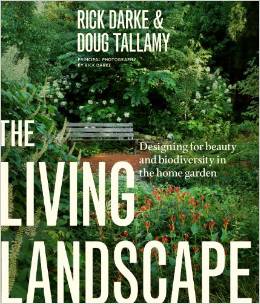By Margy Terpstra
I first found out about this new book from a link on Doug Tallamy’s website. Doug was interviewed in his home garden by Kim Eierman, founder of EcoBeneficial!
Doug describes the book near the end of the interview as, “Two-thirds Rick’s book, one-third mine. I like to talk about it as Rick’s book that I helped with.”
The book takes the message of Doug Tallamy’s first book, Bringing Nature Home, and expands upon why we need to do exactly that. It emphasizes that the goal is not just to garden with native plants, but “how native plants can play essential roles in gardens designed for multiple purposes, with a focus on proven functionality.”
The text and photos convey the importance and beauty of having layers of plants to bring life to our landscapes. As stated in the Introduction, “The richness of life in any given landscape is generally linked to the richness and intricacy in its layering.”
 There are five chapters:
There are five chapters:
- Layers in Wild Landscapes
- The Community of Living Organisms: Why Interrelationships Matter More Than Numbers
- The Ecological Functions of Gardens: What Landscapes Do
- The Art of Observation
- Applying Layers to the Home Garden.
Doug Tallamy wrote chapters 2 and 3; Rick Darke the remainder.
The authors live in Oxford, Pennsylvania, and the book focuses on plants of the Mid-Atlantic states. However, there are helpful charts in the last chapter showing selected plants for the Southeast, Southwest, Pacific Northwest, Midwest and Mountain States, and New England. These charts are compiled by different experts and the Midwest is covered by Jim McCormac, author of Birds of Ohio.
Unfortunately, the one plant I decided to check on, Indian Pink (Spigelia marilandica), is not included in the Midwest list. It is not native to our immediate St. Louis area but just to the south and in southern Illinois. Many of us now have it in our gardens, so I was curious. It does thrive in the Mid-Atlantic and is showy on the cover as well as in other photos.
In my view, the book is beautifully done overall. As a photographer, I find the images pleasing to the eye. The photographs artistically show native plants in natural-looking settings and in interesting combinations, and speak of a tranquil coexistence with birds and wildlife. And I always learn from ‘the master’, Doug Tallamy.
Doug writes eloquently of biodiversity and how it builds stability within food webs. There are so many ecosystem benefits that we humans rely on just to live and breathe. “Natural areas are now far too small and fragmented to meet the needs of the expanding human population.” So, the book encourages us to see the beauty and function in native plants and to bring our landscapes alive by incorporating them.
Purists may not be comfortable with the mention of cultivars. However, the goal of the book is to get ‘more’ high-functioning native plants in our landscapes and not necessarily to have ‘only’ native plants. This idea is to encourage as many gardeners as possible, without laying on guilt if they are not singular in their gardening approach. We all must start somewhere.

